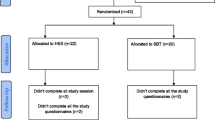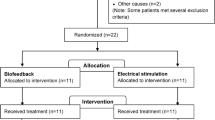Abstract
This study sought to determine the characteristics of women in whom pelvic floor electrical stimulation will reduce stress urinary incontinence. It also evaluates how long electrical stimulation should be used before significant improvements are seen in clinical outcomes. Subjects with genuine stress incontinence were enrolled into a multicenter non-randomized trial. They used electrical stimulation for 15 minutes twice daily or every other day for 20 weeks. At the end of 20 weeks, those with a 50% reduction in leakage episodes on voiding diary (‘responders’) were compared with those who did not show a 50% reduction (‘non-responders’). Thirty-one subjects were enrolled and 28 completed the study. After the treatment period, 19 subjects were defined as responders and 9 as non-responders. There were no significant differences between the two groups in baseline demographics (e.g. age, parity, largest birth weight etc.) other than body mass index (greater in nonresponders). Significant subjective and objective improvements were noted among responders by 10 and 14 weeks, respectively. Compliance was higher in responders during weeks 12–15 of the study (P=0.05). It was concluded that a minimum of 14 weeks of pelvic floor stimulation was necessary before significant objective improvements were seen. Body mass index and patient compliance may affect success.
Similar content being viewed by others
References
Caldwell KPS. The electrical control of sphincter incompetence.Lancet 1963;2:174–175
Alexander S, Rowan D, Millar W, Scott R. Treatment of urinary incontinence by electric pessary. A report of 18 patients.Br J Urol 1970;42:184–190
Erlandson BE, Fall M, Sundin T. Intravaginal electrical stimulation: clinical experiments on urethral closure.Scand J Urol Nephrol 1978;44(Suppl part 3):31–39
Fall M, Erlandson BE, Nilson AE, Sundin T. Intravaginal electrical stimulation: clinical experiments on bladder inhibition.Scand J Urol Nephrol 1978;44(Suppl part 4):41–47
Eriksen BC, Eik-Nes SH. Long-term electrostimulation of the pelvic floor: primary therapy in female stress incontinence?Urol Int 1989;44:90–95
Fall M, Erlandson BE, Nilson AE, Sundin T. Long-term intravaginal electrical stimulation in urge and stress incontinence.Scand J Urol Nephrol 1978;44(Suppl part 6):55–63
Fall M. Does electrostimulation cure urinary incontinence?J Urol 1984;131:664–667
Scott RS, Hsueh GS. A clinical study of the effects of galvanic vaginal muscle stimulation in urinary stress incontinence and sexual dysfunction.Am J Obstet Gynecol 1979;135:663–665
Blaivas JG, Oliver LM, McGuire EJ, Susset JG. Functional vaginal electrical stimulation (FVES) for the treatment of frequency and incontinence in women (abstract).J Urol 1984:131:222A
Fall M, Ahlstrom K, Carlsson CA et al. Contelle: pelvic floor stimulator for female stress-urge incontinence.Urology 1986; 27;3:282–287
Sand P, Richardson D, Staskin D et al. Pelvic floor electrical stimulation in the treatment of genuine stress incontinence: a multicenter, placebo controlled trial.Am J Obstet Gynecol 1995;1:72–79
Richardson D, Miller K, Siegel S, Karam M, Blackwood N, Staskin D. Pelvic floor electrical stimulation: a comparison of daily to every other day therapy for genuine stress incontinence.Urology 1996;48:110–118
Schiotz HA. One month maximal electrostimulation for genuine stress incontinence in women.Neurourol Urodyn 1994;13:43–50
Fall M, Lindstrom S. Functional electrical stimulation: physiological basis and clinical principles.Int Urogynecol J 1994;5:296–304
Newman D, Smith D. Pelvic muscle reeducation as a nursing treatment for incontinence.Urol Nurs 1992;12:9–15
Urinary incontinence in adults: acute and chronic management. Guidelines report. Rockville, Maryland: US Department of Health and Human Services, 1996; Agency for Health Care Policy and Research Publication No. 96-0682
Kim Y, Fahy B. Optimal electrode designs for electrosurgery, defibrillation, and external cardiac pacing.IEEE Trans Biomed Eng 1986;33:845–853
Wiley JD, Webster JG. Analysis and control of the current distribution under circular dispersive electrodes.IEEE Trans Biomed Eng 1982;29:381–385
Kinn A, Larsson B. Pad test with fixed bladder volume in urinary stress incontinence.Acta Obstet Gynecol Scand 1987;66:369–371
Wyman J, Harkins S, Choi S, Taylor J, Fantl, J. Psychosocial impact of urinary incontinence in women.Obstet Gynecol 1987;70:378–381
Barry M, Fowler F, O'Leary M et al. The measurement committee of the American Urological Association. The American Urological Association Symptom Index for benign prostatic hyperplasia.J Urol 1992;148:1549–1557
Cantril H. The pattern of human concerns. New Brunswick, NJ: Rutgers University Press, 1965;22–29
Lenz GL, Stanton SL. Urinary diary: designing a shorter diary.Int Urogynecol J 1992;3:3
Wilson P, Al Samarrai T, Deakin M, Kolbe E, Brown A. An objective assessment of physiotherapy for female genuine stress incontinence.Br J Obstet Gynecol 1987;94:575–582
Susset J, Galea G, Manbeck K, Susset A. A predictive score index for the outcome of associated biofeedback and vaginal electrical stimulation in the treatment of female incontinence.J Urol 1995;153:1461–1466
Bent AE, Sand PK, Ostergard DR, Brubaker L. Transvaginal electrical stimulation in the treatment of genuine stress incontinence and detrusor instability.Int Urogynecol J 1993;4:9–13
Meyer S, Dhenin T, Schmidt N, De Grandi P. Subjective and objective effects of intravaginal electrical myostimulation and biofeedback in patients with genuine stress urinary incontinence.Br J Urol 1992;69:584–588
Author information
Authors and Affiliations
Rights and permissions
About this article
Cite this article
Miller, K., Richardson, D.A., Siegel, S.W. et al. Pelvic floor electrical stimulation for genuine stress incontinence: Who will benefit and when?. Int Urogynecol J 9, 265–270 (1998). https://doi.org/10.1007/BF01901503
Issue Date:
DOI: https://doi.org/10.1007/BF01901503




